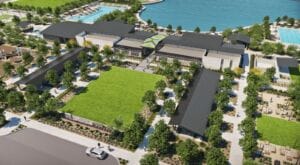Phoenix Mayor Greg Stanton announced, Wednesday, that a concept design submitted by architects at Dig Studio was selected as the winner of the second competition of the PHX Innovation Games.
In response to the call for innovators, Dig Studio’s Chad Atterbury, Brandon Sobiech, Lauren Smith and Jay Hicks submitted a design concept for the future light rail station near 48th and Washington streets and its surrounding streetscape.
Their vision focuses on access and inclusion, and it included a “table-top” style platform that would turn the station into a pedestrian plaza.
“The Dig Studio team put a lot of work into this design and carefully considered ways to address accessibility and connectivity challenges,” said Mayor Greg Stanton. “This station will be located within blocks from Ability 360 – a center that empowers and serves individuals with disabilities – so an innovative design that will make every rider comfortable and safe is paramount.”
The winning concept incorporated public art, considered sustainable solutions for channeling rainwater runoff into landscaping, and improved existing stations’ shade canopy design to offer more coverage. Solar fabric in their shade canopy design could power amenities including phone charging stations or vending machines to improve the rider experience.
“Chad, Brandon, Lauren and Jay offered an innovative and sustainable idea to make our transit system more complete,” Stanton said.
“Phoenix residents and visitors from all walks of life benefit from concepts that enhance our public transportation because of the economic development that follows,” said Maria Hyatt, Phoenix public transit director. “Innovators like the Dig Studio team are commended for their ability to explore, question and connect the dots through this challenge.”
Twelve design concepts were submitted in total and each was reviewed by a panel of staff from the City of Phoenix and Valley Metro, as well as transit experts. Concepts were evaluated based how well designers addressed accessibility through architectural plans, demonstrated an understanding for rider comfort, safety and experience and communicated their design solutions.




